When is the best time to explore all the destinations in Rajasthan?
The best time to visit Rajasthan is anytime between July and February. Summers are harsh and it is best to avoid going between March and June. There are rains during monsoon between July to September. Destinations in Rajasthan like Jaipur, Pushkar, and Udaipur look refreshing when it rains as the lakes beside the palaces fill up adding an extra touch of beauty.
Winter between October to February is the perfect time to explore all the destinations in Rajasthan as the daytime temperatures are pleasant. The nights are very cold as the temperatures drop, so carry warm clothing.
How to visit these destinations in Rajasthan?
| Travel
(with New Delhi as the starting point) |
Duration (one way) | Cost (one way)
It is cheaper when booked in advance |
| Flight | 1- 2 hours maximum | 1000 – 2000 INR ($15-30) |
| Train | 4 – 7 hours (depends on the train that is booked) | 1000 – 2000 INR ($15-30) |
| Car | 6 hours to reach the first destination Jaipur | 10000 INR to cover all the 5 destinations (upwards of $150) |
| Bus | 8 hours to reach Jaipur | 1000 – 2000 INR ($15-30) |
Rajasthan is well-connected to New Delhi. Rajasthan is well-connected intercity through a good rail network. Hence, it makes sense to take the train to travel from Delhi and between cities in Rajasthan. It makes it convenient to travel and there are scores of tourists like you, so it is safe.
Destinations in Rajasthan that you cannot miss:
Jaipur
The capital city Jaipur is one of the most popular destinations in Rajasthan.
The then Maharaja Sawai Ram Singh in the year 1876, ordered the whole city of Jaipur to be painted pink. This was done as a gesture of warm hospitality to welcome the British Prince Albert and Victoria to Jaipur. This is why Jaipur is known as the Pink City.
Few of the landmarks that make Jaipur one of the best destinations in Rajasthan are the following:
Amber Fort
Visit the 500-year-old Amber Fort, also known as Amer Fort which is just 11 km outside Jaipur. Amber Fort was built by Raja Man Singh in the 16th century. The fort is made of marbles and sandstone. It looks magnificent with the Maota Lake reflecting the colors of the fort.
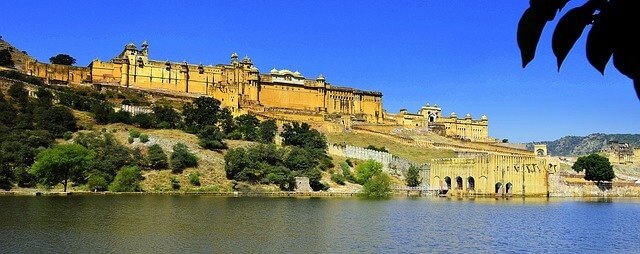
Amber Fort – Jaipur
There are many buses plying to the fort from the city bus station or you can conveniently take a cab. It costs 10 INR for domestic and 50 INR for foreign visitors to enter.
Watch out for brilliance in architecture and grandeur in the construction of forts of those days. Art is everywhere in the Amber Fort. There are frescos, paintings, inlaid work in the walls and few of the designs are inspired by the Mughals. Watch out for exquisite artwork on the many gateways and well-maintained courtyards. Read this detailed blog laden with pictures which describes the beauty of the Amber Fort in its truest sense.
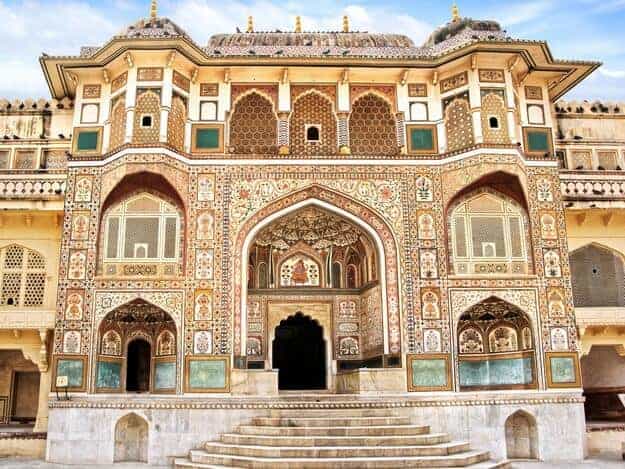
Ganesh Pol Gateway in Amber Fort
Hawa Mahal
An iconic landmark of Jaipur is the Hawa Mahal or the Palace of the Winds. Hawa Mahal is open on all days from 9:30 am to 4:30 pm. It is best to visit early at 9.30 am when the golden rays of the Sun fall on this Mahal which gives it a magical aura.

Hawa Mahal, Jaipur
It has a honeycomb structure, built in 1799 by Maharaja Sawai Pratap Singh of the Kachhwaha Rajput dynasty. Hawa Mahal is made of pink and red sandstone and it is built wide and acted as a viewing area for the Royal women. The latticed windows facilitated the royal women to watch street festivities and observe city life while remaining out of the view of the public. The stunning architecture of the interiors unfolds over five levels with 953 jharokhas or windows.
Jantar Mantar
Jantar Mantar was built in the 18th century. It is considered an architectural marvel as there are many instruments used in astronomy and the world’s largest stone sundial. This sundial can measure the time of day, accurate to half a second.
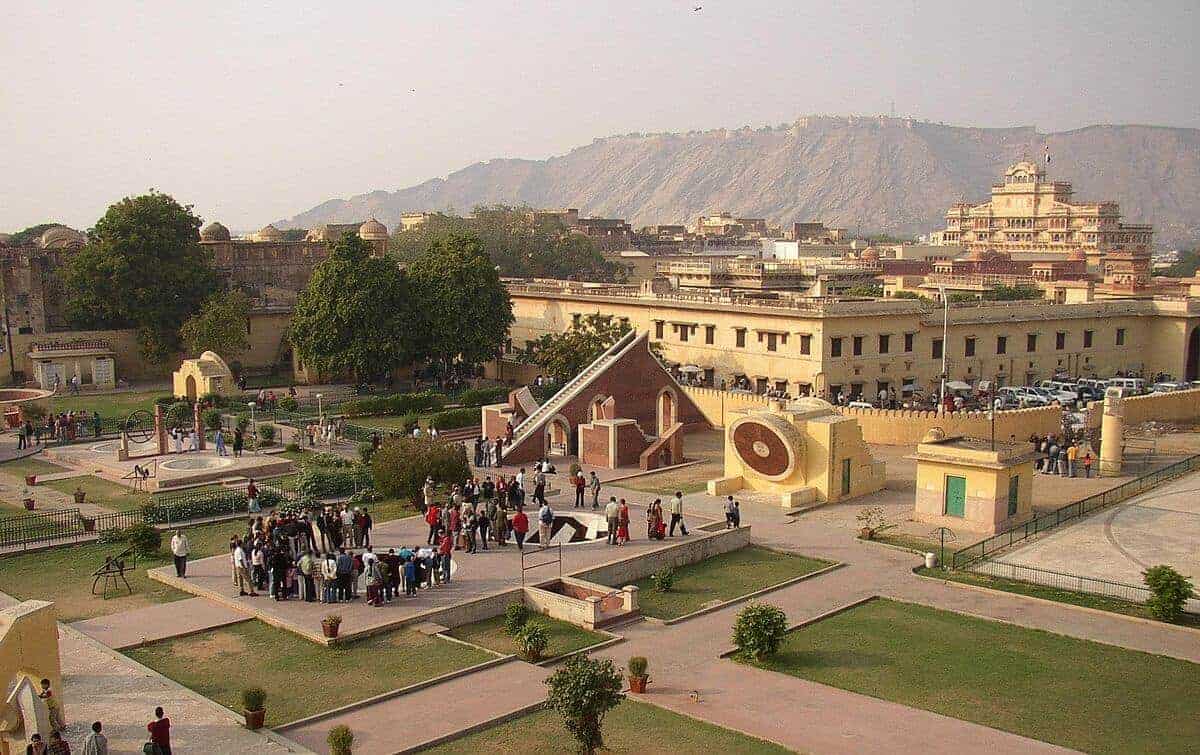
Jantar Mantar – Jaipur
These instruments help to calculate Jaipur local time, declination of the Sun and other stars, locate the Pole star, calculate the position of various constellations and more. This is rightfully a UNESCO World Heritage Site.
Pushkar, Rajasthan
Pushkar is famous for temples and the camel fair that is organized every year. It is about 150 km southwest of Jaipur. It is a deeply religious site among all the destinations in Rajasthan.
Brahma Temple
The Brahma Mandir (Brahma Temple) built using marble and rocks was made in the 14th century. It is situated near the famous Pushkar Lake. Legend has it that Lord Brahma had chosen this place for the construction of the temple himself. This temple is crowded throughout the year and is frequented by Hindus to offer prayers here.
Pushkar Lake
The Pushkar Lake provides the perfect ambiance of peace and utmost tranquility away from the crowded streets of Pushkar. The lake is surrounded by numerous temples and ghats (bathing spots) which make it a famous pilgrimage spot.
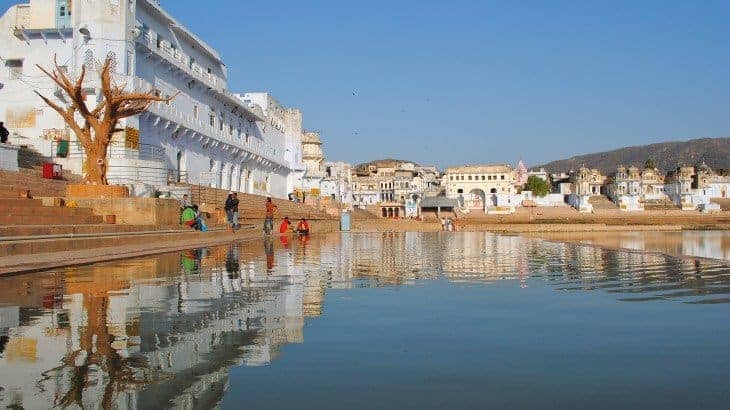
Pushkar Lake in Rajasthan.
Pic courtesy: Welcome2Rajasthan
Pushkar Camel Fair
The Pushkar Camel Fair is held every year in the month of October and November. Thousands of camels, goats, horses, and cattle are traded in this livestock fair. The fair is so colorful that it attracts many visitors from across the world. Rural families shop at the handicraft stalls full of bracelets, clothes, textiles, and fabrics.
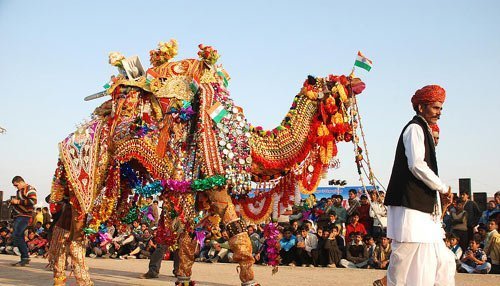
Pushkar camel fair – Rajasthan India
Jodhpur, Rajasthan
The bustling streets of Jodhpur are what beckons you when you first step into Jodhpur. Though chaotic at first sight, after a while you will see the local life unfold when you enter the narrow lanes on your way to Mehrangarh Fort. The fort sits majestically on a rocky hill which fills the skyline of Jodhpur. Watch this interesting video to see how to make the most of Jodhpur when you are here.
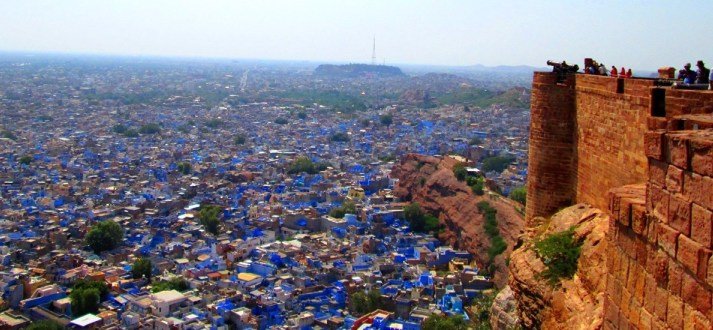
Blue City Jodhpur
Pic courtesy: Erco Travels
Mehrangarh Fort, Jodhpur
The fort has an entry fee of 60 INR for Indian and 400 INR for foreigner visitors. The chief of the Rathore clan, Rao Jodha, built Mehrangarh Fort in 1460. Imposing thick walls enclose the fort 410 ft above the city. Just like all the other forts in Rajasthan, the Mehrangarh Fort encompasses palaces, large courtyards, thick gates and temples all within the complex.
The view of the city of Jodhpur from the walls of the fort is fantastic. Indians call Jodhpur the Blue City of Rajasthan because all the houses are blue. People paint them because that keeps the houses cool during the summer.

